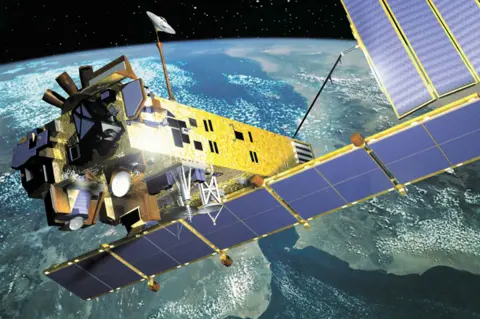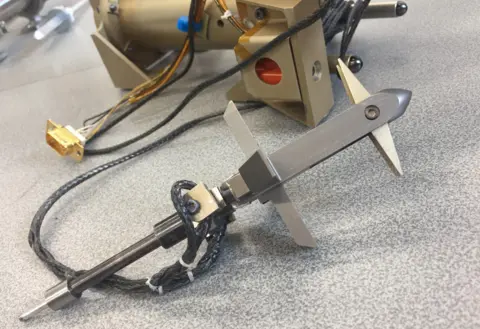Big harpoon is 'solution to space junk'
Airbus is testing a big harpoon to snare rogue or redundant satellites and pull them out of the sky.
The 1m-long projectile would be attached, through a strong tether, to a chase spacecraft.
Once the target was captured and under control, the chase vehicle would then drag its prey down into the atmosphere to burn to destruction.
Airbus has been working on the concept for a number of years now, developing ever bigger systems.
It is a response to the growing problem of orbital junk - old pieces of hardware that continue to circle the globe and which now pose a collision threat to operational satellites.
 ESA
ESASomething in the region of 20,000 items of 10cm or larger are currently being tracked.
The latest Airbus harpoon is being designed with the capability to capture one of the biggest rogue items of the lot - Europe's defunct Envisat Earth observation platform.
This 8-tonne behemoth died suddenly in orbit in 2012. "Envisat is the outlier," explained advanced project engineer Alastair Wayman.
"If we can design a harpoon that can cope with Envisat, then it should be able to cope with all other types of spacecraft including the many rocket upper-stages that remain in orbit."
The testing at the aerospace company’s facility in Stevenage, UK, involves firing the harpoon, using compressed air, into a panel that is representative of the kinds of material used to build satellite structures.
Typically, this takes the form of 3cm-thick, composite honeycomb panels that incorporate a lot of aluminium.
"The harpoon goes through these panels like a hot knife through butter," said Mr Wayman.
"Once the tip is inside, it has a set of barbs that open up and stop the harpoon from coming back out. We'd then de-tumble the satellite with a tether on the other end."
This is where harpoons should come into their own, over other methods of capture such as nets and robotic arms. A harpoon is relatively simple. You line up the target and shoot.
"Many of these targets will be tumbling and if you were to use a robotic arm, say, that involves a lot of quite complex motions to follow your target," Mr Wayman explained.
"Whereas, with the harpoon, all you have to do is sit a distance away, wait for the target to rotate underneath you, and at the right moment fire your harpoon. And because it's a really quick event, it takes out a lot of the complexity."

You still have to bring the tumbling satellite under control using thrusters on the chase vehicle - but computer simulations show this should be possible.
The European Space Agency, which is responsible for Envisat, is considering all options at the moment, and the demonstration missions that fly in the next few years will almost certainly go for easier, more cooperative targets first. Indeed, a miniature version of the Airbus harpoon is set to launch next month on a mission called RemoveDebris.
This demonstrator satellite, developed at the Surrey Space Centre, will carry its own piece of junk which it will release and then attempt to retrieve. It will trial a net, but will perform a harpoon test as well to further knowledge about how such systems will behave in the weightless environment of space.
For the big harpoon back in Stevenage, it is now ready to move to its next development stage. This will involve firing the projectile over a distance of 25m, the sort of separation over which the real flight model would have to work.
[email protected] and follow me on Twitter: @BBCAmos
